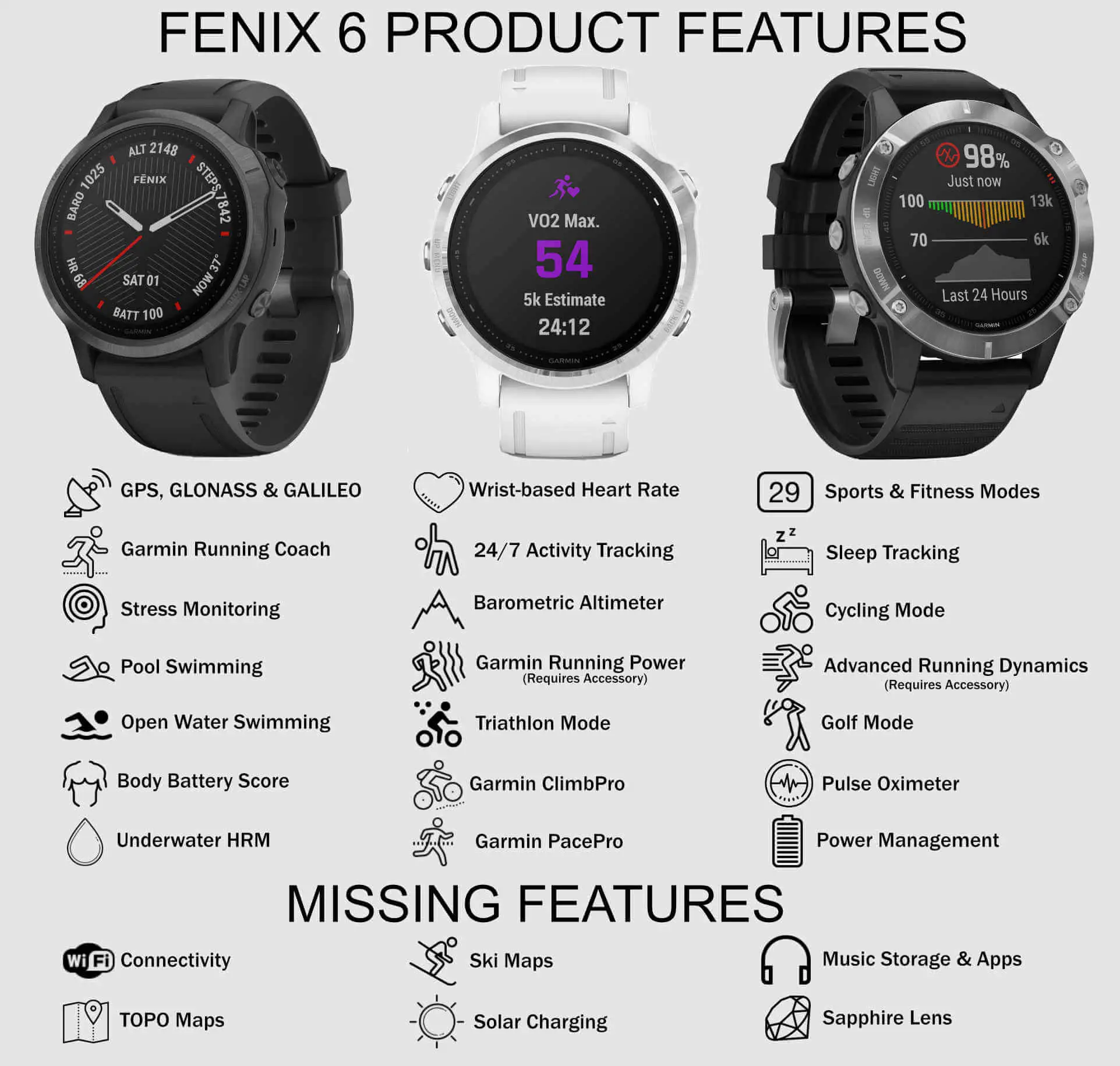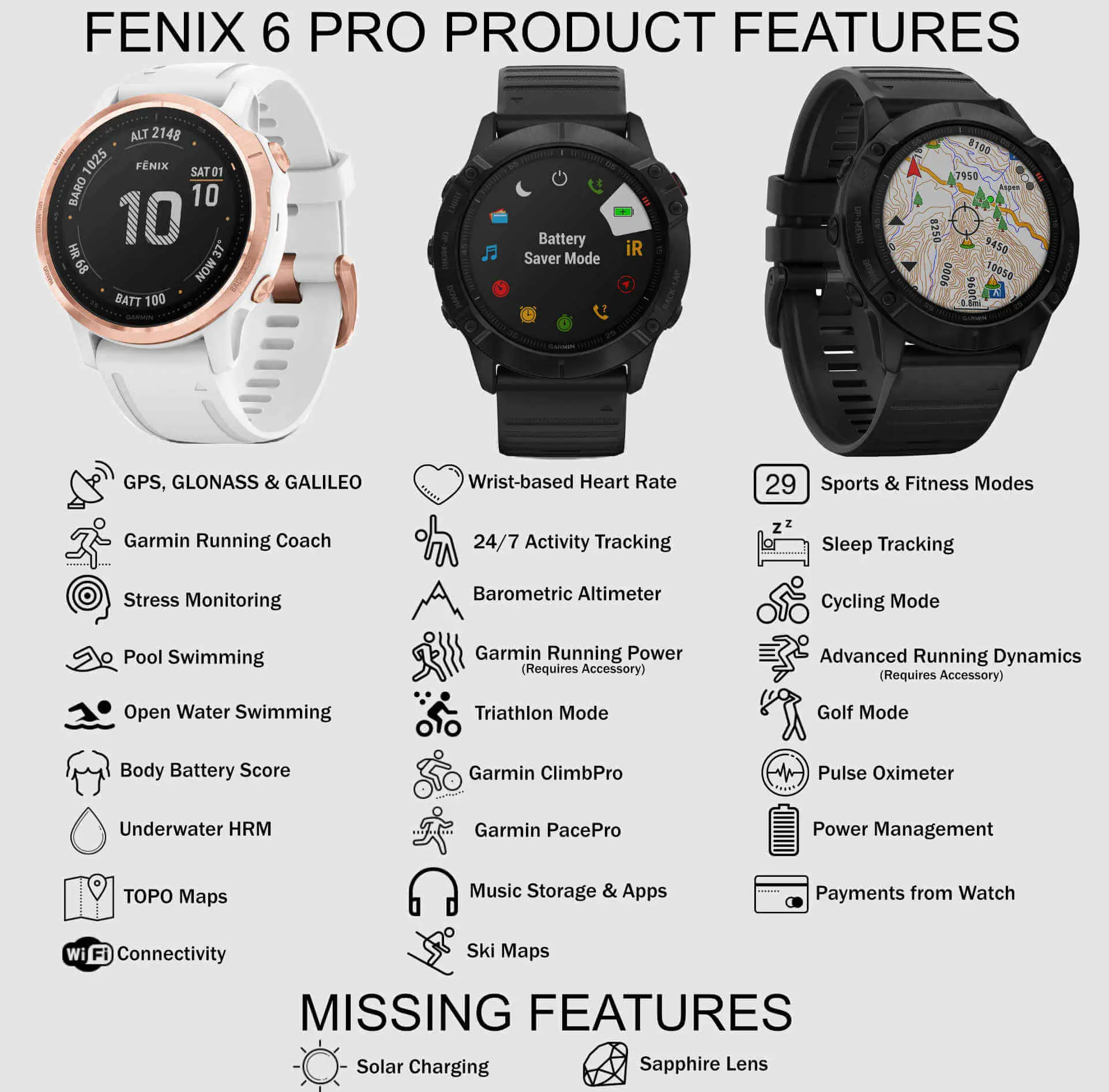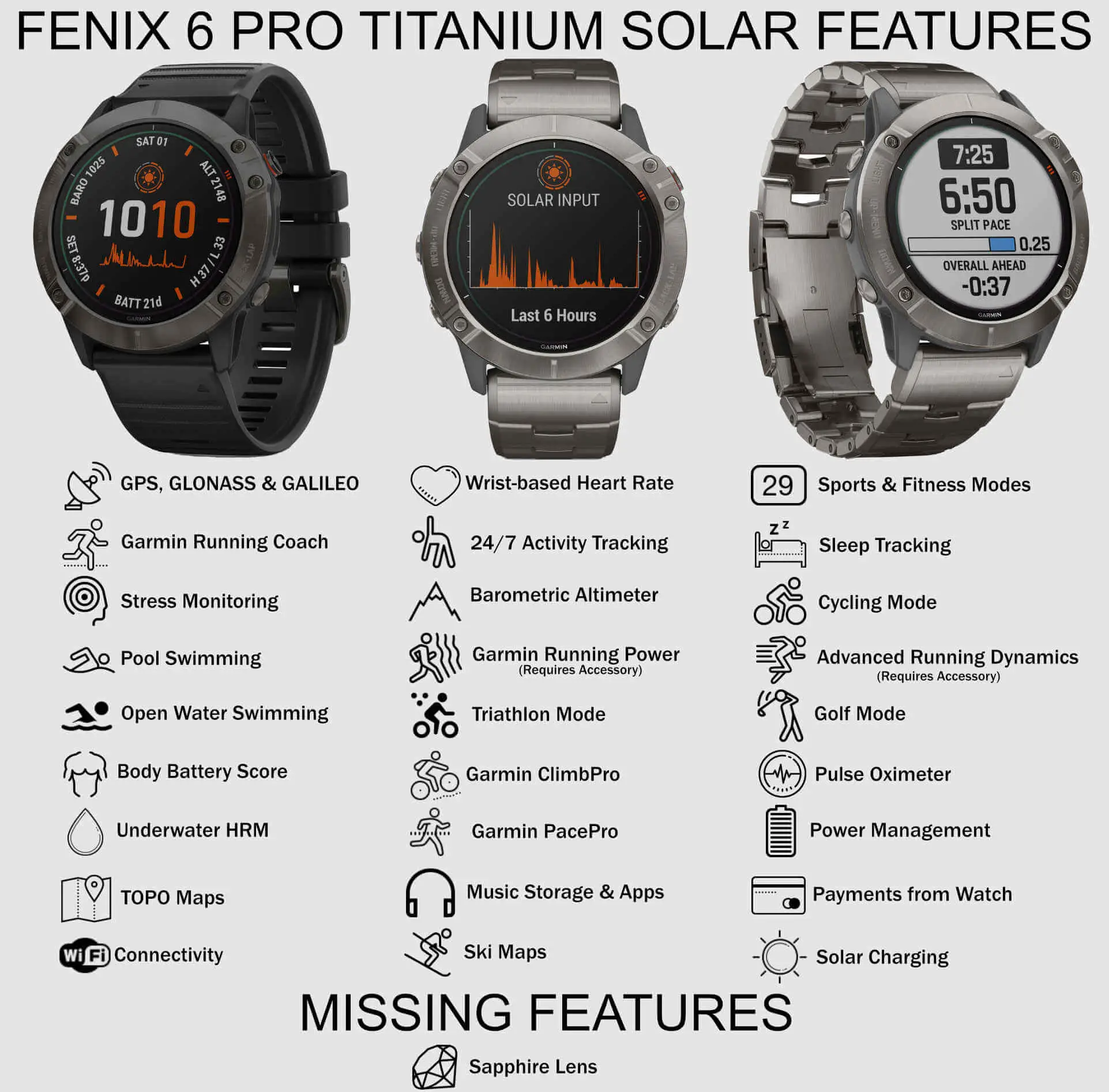GARMIN FENIX 6 COMPARISON CHART

Let’s be honest. The Garmin Fenix range has never been better, but at the same time, it’s also become very confusing.
There are literally 20 different versions to choose from, and they all seem to have slightly different features, battery life settings and construction materials.
Fortunately, we’ve decided to do a bit of the hard work for you. The goal of this post is to explain the major differences between all the different Fenix 6 models, using super simple charts, in a highly visual format. If that sound like what you’re looking for, you’re in the right place.
But before we dive in, it’s worth emphasizing that there are essentially 4 different types of Fenix 6.
- Garmin Fenix 6 (Base Model)
- Garmin Fenix 6 Pro
- Garmin Fenix 6 Sapphire
- Garmin Fenix 6X Pro Solar Titanium
And yes, there is a small version (look out for the letter S at the end of the product title) for every type, except the 6X Pro Solar Titanium.
Now we’re ready to unpack the main features of each different model.
Standard Fenix 6 Features Comparison Chart

As you can see from the Garmin Fenix 6 Comparison Chart above, there are clearly some missing features in the standard Fenix 6. In my opinion, it would have been more appropriate to call the standard version the Fenix 6 Lite.
What features are missing from the standard Garmin Fenix 6?
In short, the standard Fenix 6 lacks the following features:
- WiFi Connectivity – This is arguably the biggest weakness of the standard version. WiFi connectivity can be a lot faster and more convenient than Bluetooth for transferring training data to Garmin connect on your phone or PC.
- Music Storage & Apps – The standard Fenix 6 doesn’t have music storage functionality, and you can’t use apps like Spotify, Deezer or Amazon music.
- TOPO Maps – This has been a key selling point of the Fenix range, so it’s a bit sad to see it removed from the base level Fenix 6. It’s particularly useful for hiking, trail running, mountain biking and adventure racing, so if you have your heart set on powerful nagivation technology, you will need to upgrade the Fenix 6 Pro, Fenix 6 Sapphire, or the Fenix 6 Pro Titanium model.
- Ski Maps – This is another let down for the cheaper Fenix 6. Naturally this only affects skiiers and snowboarders. Basically, you lose out on thousands of Ski resort maps which detail the slope difficulty and overall terrain.
- Sapphire Lens – The standard Fenix 6 doesn’t have a Sapphire lens, which is essentially Garmin’s most scratch resistant surface. Fortunately, the base level Fenix 6 is built with Corning® Gorilla® Glass DX, which is more than strong enough for most people.
- Solar Charging – Although this is definitely missing from the entry level Fenix 6, it’s worth pointing out that only the Fenix 6 Pro Solar Titanium actually has solar charging (ie the most expensive version). Also, even though the concept of solar charging is pretty cool, in reality it’s not very effective in real life. In fact, you will be far better served by the improved Fenix 6 battery life, which applies to every product in the range.
Garmin Fenix 6 Pro Comparison Table

Next on the hierarchy we have the Garmin Fenix 6 Pro. If you’re looking for the best value for money, there’s a strong argument for the Fenix 6 Pro. It’s easy to say this, because the Pro model has all the same core technology as the most expensive version in the range (the Fenix 6 Pro Solar Titanium).
What's the difference between the Fenix 6 and the Fenix 6 Pro?
Unlike the Fenix 6 Base Model (which should actually be called the Fenix 6 Lite), the Fenix 6 Pro has the following key features built-in:
- Topo Maps – This is a massive win if you enjoy hiking, trail running, mountain biking, mountaineering or adventure racing. Garmin’s TOPO map technology is legitimately awesome.
- Ski Maps – Garmin have used their TOPO map technology to build thousands of ski resort maps. These give you the difficulty of the slope and a 3D map of the terrain.
- WiFi Connectivity – Don’t underestimate the convenience of WiFi connectivity. It makes it much easier to transfer data to Garmin connect on your phone or your laptop.
- Music storage and apps – This is another huge win for the Fenix 6 Pro. You essentially gain storage capacity for 2000 songs, and you can use popular music apps like Spotify, Deezer and Amazon Music.
What features are missing from Fenix 6 Pro?
There are only 2 key features missing from the Fenix 6 Pro. Here they are:
- Solar Charging – As mentioned earlier in the article, only the Fenix 6X Pro Solar Titanium has solar charging functionality.
- Sapphire Lens – You lose out on Garmin’s most scratch resistant lens material (sapphire). However, the Fenix 6 Pro is built with Corning® Gorilla® Glass DX, which is still a premium material that will definitely protect your watch.
Garmin Fenix 6 Sapphire Comparison Chart

What's the difference between the Fenix 6 Pro and the Fenix 6 Sapphire
There are 3 primary differences between the Fenix 6 Pro and the Fenix 6 Sapphire.
- Sapphire Lens – This is literally Garmin’s most scratch resistant lens material. It’s the biggest advantage of choosing the Sapphire version over the Pro version.
- It’s more expensive – It goes without saying, but you definitely have to pay a bit more for the premium lens material.
- There’s a titanium version – If you’re looking for a badass mutlisport watch that looks more like a TAG Heuer, the Fenix 6 Sapphire titanium is the watch for you. It gives you that sophisticated design, while packing all the best technological features that Garmin has to offer.
Outlandish Claim Alert
I don’t often make outlandish claims, but in this case I’m going to put my neck on the line. In my opinion, the Fenix 6 Sapphire is actually the best version in the Fenix 6 family. Why you ask? There are 2 main reasons.
- The Sapphire Lens Has More Practical Value than the Solar Charging Lens – Garmin have done themselves proud with the massive battery life improvements (when compared to the Fenix 5 Plus). However, the reality is that solar charging isn’t nearly as useful as you might think. It basically gives you a negligible increase in battery life between charges. On the other hand, the sapphire lens has a very direct benefit. It’s by far the most scratch resistant material, which ultimately means a tougher watch that will age better over time.
- The Sapphire Colour Options Are Better – From a design perspective, Garmin have absolutely nailed it with the Sapphire versions. There’s the stock standard carbon gray, the ultra sleek rose gold powder gray, the deep black with red wristband and the premium titanium version. All of them look awesome.
What features are missing from Fenix 6 Sapphire?
In essence, there is only 1 key feature missing from the Fenix 6 Sapphire. Here it is:
- Solar Charging – I hate to sound like a broken record, but we need to make this super clear. Only the Fenix 6X Pro Solar Titanium has solar charging functionality. Despite this so called “weakness” my feeling is that the scratch resistant sapphire lens is actually more useful than solar charging lens.
Garmin Fenix 6X Pro Solar Titanium

Finally we come to the most expensive siblings in the Fenix 6 Family. Meet the Fenix 6X Pro Solar Titanium. This is the only version that includes solar charging, which is by far the biggest innovation from Garmin in the last 18 months.
What's the difference between the Fenix 6X Sapphire and the Fenix 6 Pro Solar Titanium?
There are 3 main differences between the Fenix 6 Sapphire and the Fenix 6 Pro Solar Titanium.
- Solar Charging – Only the Fenix 6X Pro Solar Titanium includes the screen needed for solar charging. This should come as no surprise given the product title, but it’s worth emphasizing at this point in the conversation.
- It only comes in the 51mm Version – Basically, when you see the letter ‘X’ added to the product title, it means it’s the largest option available in the product family (in this case 51mm). This is markedly different to the Sapphire version, which comes in 42mm, 47mm and 51mm.
- It’s the most expensive option – Both versions of the Fenix 6X Pro Solar titanium cost some serious cash dollar. Expect to drop between $999 and $1149 for one of these bad boys.
- It doesn’t have a Sapphire Lens – Like it or not, this is actually a chink in the armour of the Fenix 6 Pro Solar Titanium version. You lose out
So which one should you buy?
I hope this article has helped you understand the differences between all the Fenix 6 models. To cap it off, here are some super simple thoughts on which one you should choose, if you’re still on the fence.
Fenix 6 (Base Model) – Go for this option if you can live without music, topo maps and wifi charging. By choosing the streamlined version ($599) you can pay almost 50% less than you would for the most expensive version ($1149).
Fenix 6 Pro – If you want the best value for money, the Fenix 6 Pro is probably your best bet. You get all the key technological features of the Fenix 6 product line-up, without paying a premium price for the lens material or solar charging.
Fenix 6 Sapphire – In my opinion, this is the best variant of the Fenix 6 product line up. You get the best quality lens material and the best looking design options. If money isn’t too much of a problem, it’s hard to go wrong with this choice.
Fenix 6X Pro Solar Titanium – I will happily admit that solar charging is a big innovation from Garmin, but the fact of the matter is that the battery life of your watch is infinitely more important (and all the Fenix 6 products have very respectable battery lives). So from my perspective, there is no compelling reason to go for the Fenix 6X Pro Solar Titanium. Solar charging is a cool concept, but ultimately it doesn’t have that much practical value. For that reason, I think you would be better served by the Fenix 6 Pro or the Fenix 6 Sapphire if you want all the best technology that Garmin has to offer.
